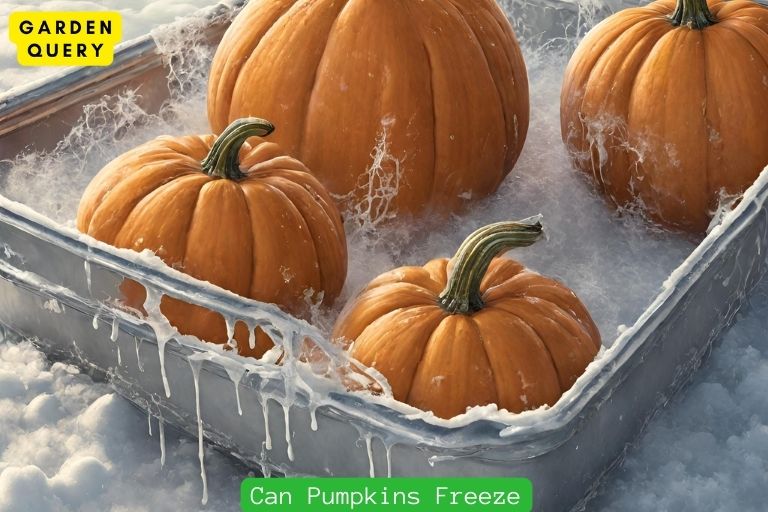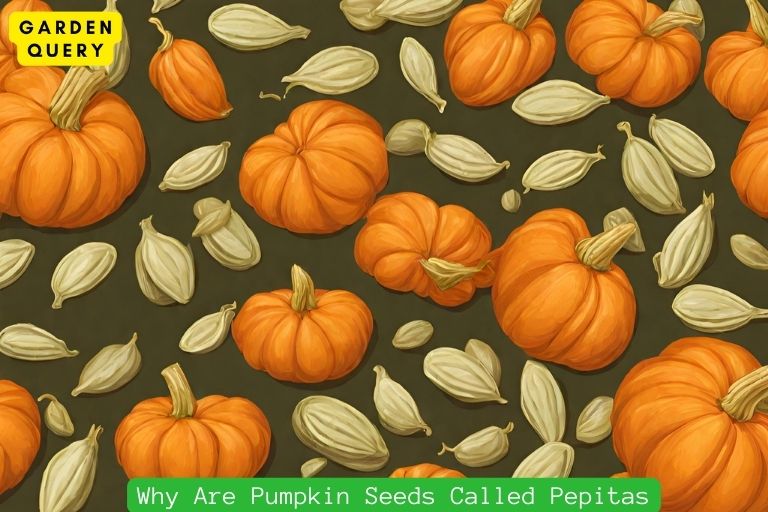Can Pumpkins Freeze?
Can Pumpkins Freeze
What happens to pumpkins in freezing temperatures?
When exposed to freezing temperatures, pumpkins can be adversely affected. The internal structure of the pumpkin consists of cells that contain water. When water freezes, it expands, leading to cellular damage. This can cause the pumpkin to become soft, mushy, and prone to rotting. Additionally, freezing temperatures can lead to the breakdown of the pumpkin’s cell walls, resulting in a loss of structural integrity.

Is it possible for pumpkins to freeze?
Yes, pumpkins can freeze if they are exposed to temperatures below 32°F (0°C) for an extended period. Freezing temperatures can occur during the fall and winter seasons in many regions. It is important to protect pumpkins from freezing to maintain their quality and prevent them from deteriorating.
To prevent pumpkins from freezing, consider the following tips:
- Harvest before freezing temperatures: Monitor the weather forecast and harvest your pumpkins before the first frost or freeze. Ideally, pumpkins should be picked when they are fully mature but before any freezing conditions occur.
- Store in a cool, dry place: After harvesting, store pumpkins in a cool, dry area such as a garage or basement. Make sure to keep them off the ground and provide proper ventilation to prevent moisture buildup.
- Protect with insulation: If you anticipate freezing temperatures, you can protect your pumpkins by covering them with blankets, straw, or cardboard. This insulation will help maintain a slightly higher temperature around the pumpkin, reducing the risk of freezing.
- Use a cold frame or greenhouse: If you have access to a cold frame or greenhouse, you can extend the life of your pumpkins by providing them with a protected environment. These structures can help regulate temperature and shield the pumpkins from freezing temperatures.
- Preserve by canning or freezing: If freezing temperatures are imminent and you’re unable to protect your pumpkins, consider preserving them by canning or freezing. This way, you can still enjoy pumpkin recipes even after the harvest season.
In conclusion, pumpkins are susceptible to damage from freezing temperatures. To maintain their quality and prevent freezing, harvest them before the first frost, store in a cool, dry place, protect with insulation, or consider preserving them through canning or freezing. By taking these precautions, you can ensure that your pumpkins remain fresh and ready for use throughout the fall and winter months.
Factors Affecting Pumpkin Freezing
Have you ever wondered if pumpkins can freeze? This is a common question that arises as the temperature drops and Halloween approaches. The answer is yes, pumpkins can freeze, but there are certain factors that affect their ability to withstand freezing temperatures.
Temperature thresholds for pumpkin freezing
Pumpkins are comprised mostly of water, which means they have a high freezing point similar to other fruits and vegetables. The freezing point of pumpkins is around 32 degrees Fahrenheit (0 degrees Celsius). When the temperature drops below this threshold, the water inside the pumpkin starts to freeze. This can cause the pumpkin to become mushy and lose its structural integrity.
It’s worth noting that different varieties of pumpkins may have slightly different freezing points due to variations in their water content. However, in general, pumpkins are not able to withstand freezing temperatures for extended periods.
Moisture content and impact on freezing
The moisture content of a pumpkin can also impact its ability to freeze. Pumpkins with a higher moisture content are more prone to freezing and subsequent damage. This is because the water inside the pumpkin expands as it freezes, leading to cell rupture and a mushy texture.
To minimize the risk of freezing, it is advisable to store pumpkins in cool, dry places where the temperature remains above freezing. If you live in an area with cold winters, it is recommended to harvest your pumpkins before the first freeze or bring them indoors to protect them from freezing temperatures.
It’s important to note that freezing can also affect the flavor and texture of pumpkin flesh. Once a pumpkin has been frozen and thawed, its texture can become mealy and the flavor may be altered. Therefore, it is best to use frozen pumpkins for cooking or baking rather than eating them raw.
In conclusion, pumpkins can freeze when exposed to temperatures below their freezing point. Factors such as temperature thresholds and moisture content can influence the extent of freezing and subsequent damage to the pumpkin. It is best to store pumpkins in cool, dry places to prevent freezing and protect their quality.
Effects of Freezing on Pumpkins
With the fall season in full swing and an abundance of pumpkins available, many people wonder if they can freeze these festive gourds for later use. If you’re considering storing pumpkins in the freezer, it’s essential to understand the potential effects it may have on their physical attributes, quality, and taste.
Physical changes in frozen pumpkins
When pumpkins are frozen, they undergo certain physical changes that can impact their appearance and texture upon thawing. These changes include:
- Softening: Freezing causes the water inside the pumpkin cells to expand, leading to cell rupture and subsequent softening of the flesh. As a result, frozen pumpkins may become mushy or watery once defrosted.
- Texture alteration: The freezing process can alter the cellular structure of the pumpkin, resulting in a softer and grainier texture. This change in texture may not be desirable for certain culinary applications.
- Color changes: Freezing can cause the pumpkin’s vibrant orange color to fade and become dull. While this may not impact the taste, it can affect the visual appeal of dishes or decorations made with frozen pumpkins.
Quality and taste alteration
In addition to physical changes, freezing can also impact the overall quality and taste of pumpkins. Here are a few considerations:
- Loss of freshness: Pumpkins are best when consumed fresh, as freezing can result in a loss of flavor and freshness. The freezing process can compromise the natural sweetness and aromatic qualities that make pumpkins appealing.
- Water content: As mentioned earlier, freezing causes the water inside the pumpkin cells to expand, leading to cell rupture and potential water loss. This loss of moisture can further affect the quality and taste of the pumpkin.
- Flavor alteration: Some individuals may notice a slight change in the taste of frozen pumpkins compared to fresh ones. The freezing process can alter the flavor profile, making it slightly blander or less intense.
It is important to note that while freezing may affect the physical attributes, quality, and taste of pumpkins, it can still be a viable option for long-term storage purposes. If you plan to freeze pumpkins, it is recommended to use them in recipes that involve cooking, as this can help mitigate some of the texture and flavor changes.
In conclusion, freezing pumpkins can result in physical changes such as softening, texture alteration, and color fading. It can also lead to a loss of freshness, potential water loss, and slight flavor alteration. While freezing may affect the overall quality and taste of pumpkins, it can still be a convenient method for preserving these seasonal delights.
Protecting Pumpkins from Freezing
Preventive measures to avoid pumpkin freezing
As the temperatures drop and the winter season sets in, pumpkin lovers may find themselves wondering: can pumpkins freeze? The answer is yes. Freezing temperatures can cause pumpkins to become soft, mushy, and inedible. To avoid this unfortunate outcome, here are some preventive measures you can take:
- Harvest at the right time: Before the first frost hits, make sure to harvest your pumpkins. Ideally, you should harvest them when they are fully ripe, with a hard shell and a vibrant color. Immature pumpkins are more susceptible to freezing.
- Protect from extreme temperatures: If freezing temperatures are in the forecast, cover your pumpkins with blankets or tarps to shield them from the cold. Alternatively, you can bring them indoors to a cool, dry place.
- Insulate the ground: To provide additional protection, place a layer of straw, hay, or mulch underneath the pumpkins. This helps insulate the ground and keeps the pumpkins from freezing.
- Maintain proper air circulation: Avoid piling pumpkins directly on top of each other. Instead, provide space between them to ensure good air circulation. This helps prevent moisture buildup and potential freezing.
Proper storage techniques for pumpkins
If you’ve successfully protected your pumpkins from freezing during the winter season, you may ask yourself how to store them properly to extend their shelf life. Follow these storage techniques to keep your pumpkins fresh and in good condition:
- Clean and dry: Before storage, clean your pumpkins by gently wiping off any dirt or debris. Allow them to air dry completely to prevent mold growth.
- Store in a cool, dry place: Find a cool and dry location to store your pumpkins. Basements, garages, or root cellars are ideal options. The temperature should be between 50-55°F (10-13°C) with low humidity.
- Avoid direct contact with the floor: Place your pumpkins on a raised surface, such as a wooden pallet or cardboard, to prevent moisture from seeping in.
- Check for any signs of spoilage: Regularly inspect your stored pumpkins for any signs of rot or decay. Remove any affected pumpkins immediately to prevent spoilage from spreading to the rest.
By taking these preventive measures and using proper storage techniques, you can ensure that your pumpkins remain fresh and avoid freezing. Whether you’re using them for carving, cooking, or simply decoration, a well-preserved pumpkin can bring joy throughout the winter season.
Utilizing Frozen Pumpkins
When it comes to pumpkins, the first thing that comes to mind is carving them into spooky Jack-o’-lanterns or enjoying pumpkin pie during the holiday season. But what happens if you have an abundance of pumpkins and want to save them for later use? Can pumpkins freeze? The short answer is yes, you can freeze pumpkins! Freezing can be an excellent way to preserve the freshness and flavor of pumpkins for future use. Let’s explore how you can make the most of your frozen pumpkins.
Using frozen pumpkins in cooking or baking
Freezing pumpkins provides a convenient way to have pumpkin puree available whenever you need it. Here’s how you can use your frozen pumpkins in your cooking or baking endeavors:
- Pumpkin puree: After thawing your frozen pumpkins, you can turn them into pumpkin puree. This puree can then be used as a base for delicious pumpkin pies, desserts, soups, or even in savory dishes.
- Pumpkin soup: The frozen pumpkins can also be used directly in preparing pumpkin soup. Simply defrost the pumpkin, blend it with the other ingredients, and simmer it into a hearty and flavorful soup.
- Breads and muffins: Incorporate the thawed pumpkin puree into your favorite bread or muffin recipes for a moist and aromatic result. Whether it’s pumpkin bread, pumpkin muffins, or even pumpkin pancakes, your frozen pumpkins can add a delightful twist to your baked goods.
Alternative uses for frozen pumpkins
Apart from cooking and baking, there are other creative ways to make use of your frozen pumpkins:
- Festive decorations: Frozen pumpkins can still be partially thawed and carved into decorative pieces. Although they may not last as long as fresh pumpkins, they can still be enjoyed as unique decorations during the holiday season.
- DIY beauty treatments: Pumpkin is known for its nourishing properties, particularly for the skin. Thawed pumpkin pulp can be used as a face mask or added to homemade scrubs to exfoliate and hydrate the skin.
- Fertilizer: If you have a garden, thawed pumpkins can be composted or used as natural fertilizer. Pumpkins are rich in nutrients, and their decomposition will enrich the soil and contribute to healthier plant growth.
In conclusion, freezing pumpkins provides a practical way to preserve them for future use. Whether you use the thawed pumpkins in cooking, baking, or explore alternative uses, you can enjoy the flavors and benefits of pumpkins long after the harvest season. So go ahead and freeze those pumpkins to have a taste of autumn all year round!
- Best Therapists In Dallas - February 1, 2024
- Holly Willoughby Husband: Holly Willoughby’s Love Story - January 30, 2024
- Holly Willoughby Dress: 5 Style Secrets and 7 Must-Know Career Milestones - January 30, 2024





